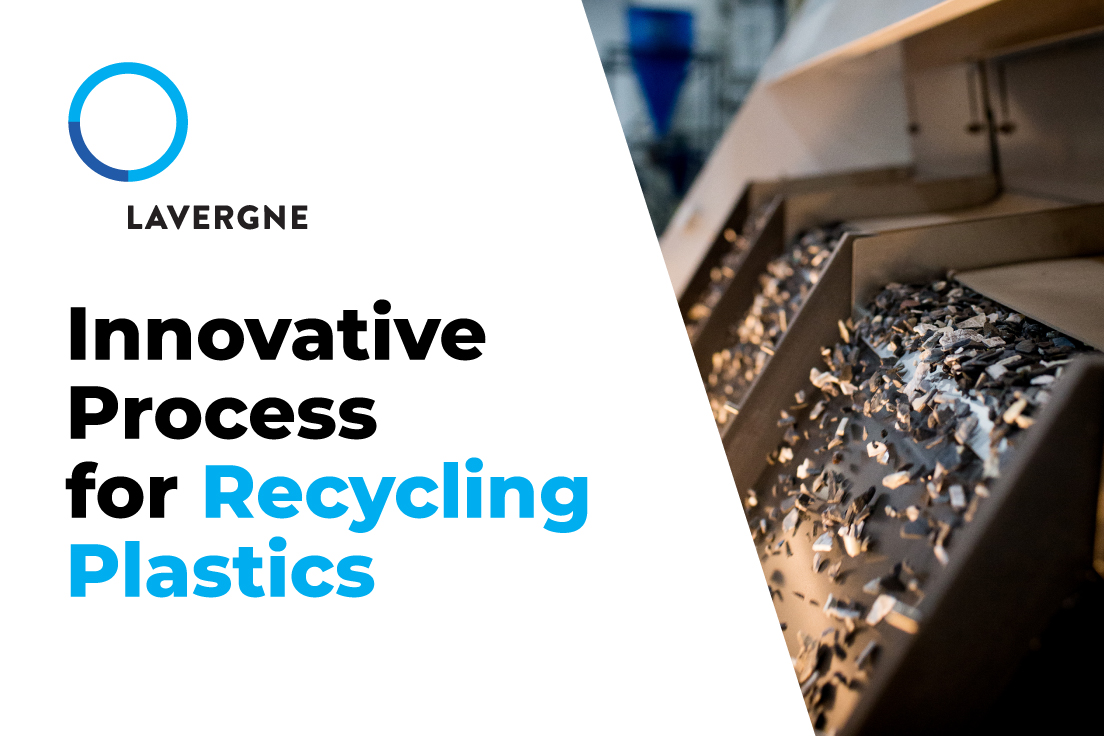As a leading plastics recycling company, we talk a lot about innovation and building a Closed Loop where used plastics become the feedstock for reprocessing them into new plastics.
At Lavergne, we believe there is enough plastic on earth to meet our future needs without ever creating new virgin plastic.
It’s an important development for the future of our economy and the health of our planet. People are getting onboard — households are using blue bins, governments are banning single-use plastics, buyers are following eco-labels, and companies are changing their packaging practices.
How do those recycling practices turn old materials into new plastics?
It’s an advanced process. Let’s have a look.
An Innovative, Automated Process
The plastic recycling process at Lavergne’s Montreal facility is entirely automated.
When the feedstock enters the Lavergne facility, it follows a transformative process of turning old used plastics into new Post-Consumer Recycled (PCR) resins.
The process follows specific steps: shredding, separating, cleaning, mixing additives, and reactive compounding. We organize the steps in three separate centers called:
- Plastic Care Center
- Additive Mixing Center
- Reactive Compounding Center
One of our unique innovations in doing business in a COVID-19 environment is using virtual technology to give plant tours of the Montreal facility. Those tours show each step of the process in each of the three centers.
Plastic Care Center
The Plastic Care Center truly cares for the old plastics. Those used plastics are not headed for landfill. In the Plastic Care Center, we care for them, treat them and work to restore them. We do it all without additives. At this point we’re building on the strength of those existing plastics by cleaning and separating by type and color.
In the Plastic Care Center, the feedstock goes through an automated process of:
Shredding — The feedstock is shredded into small flakes
Cleaning — The flakes are thoroughly washed, rinsed and dried
Separating — The plastic flakes are separated by type and colour. Lavergne’s automated system can identify and sort the individual flakes by plastic types, and also by colour, as black, white and “mixed” coloured plastics are automatically separated
Lavergne’s quality control processes ensure the plastics are properly segregated, all contaminants are removed, and the flakes are sorted.
Once completed, the cleaned plastic makes its way to one of 16 mixing silos where they are mixed to ensure homogenization.
Additive Mixing Center
In the additive mixing center, the base polymers are melted and blended with additives — Lavergne’s “secret sauce” — to rebuild and strengthen the molecular chain. The additives ensure the new resin meets specifications include performance properties and color matching.
Reactive Compounding Center
During the reactive compounding phase, the material is melted together with additives. The compound goes through an extrusion process and is then “pelletized,” or turned into pellets.
Innovation Producing Significant Benefits
Looking across the process, we can point to some real benefits.
Tailored to Individual Customers — Our recycling process is the place where Lavergne’s science aligns with our customers’ business priorities — each individual process is tailored to meet each customer’s specific needs.
Collecting from a Range of Collection Streams — The feedstock of used plastics comes to Lavergne through a range of collection streams.
- At Lavergne’s operations on the Caribbean island nation of Haiti, used plastics are picked up from the country’s towns, roadways, waterways and informal landfills by independent collectors who deliver them to collection centers throughout the country. Lavergne pays the collectors by the weight of collected plastics. The discarded items are referred to as Ocean Bound Plastics (OBP), and collecting and delivering them to Lavergne diverts them from polluting marine life. At the same time, the collection and plant operations creates a new market, new jobs and greater economic benefits throughout Haiti’s local communities.
- Lavergne also recycles significant amounts of electronic waste or “e-waste” such as old computers, laptops, smartphones, printers, and computer mice. E-waste comes to Lavergne’s facility through our partnerships with companies that collect the old devices.
Consistent Quality Control — Throughout the entire process, Lavergne’s commitment to quality remains unwavering. The quality commitment is built on:
- Precision feeding systems
- Continuous process monitoring
- Certified quality testing labs
The entire process is the core of our Closed Loop system.
The Final Product — Post-Consumer Recycled (PCR) Plastics
The Lavergne process creates 100% Post-Consumer Recycled (PCR) plastics of base polymers, including:
- Recycled Polyethylene Terephthalate (“rPET”)
- Recycled Acrylonitrile Butadiene-Styrene (“rABS”)
- Recycled High-Impact Polystyrene (“rHIPS”)
- Recycled Polycarbonate (“rPC”)
- Recycled Polypropylene (“rPP”)
All products are made for injection molding processes, and tailored to fit specific applications.
You can see these products come together in Lavergne’s product suite, including:
- The VYPET™ series created from clean post-consumer recycled Polyethylene Terephthalate (PET), often proven suitable to serve applications in automotive manufacturing, electrical components, and appliances and furniture
- The VYTEEN™ series is created from post-consumer recycled Acrylonitrile Butadiene-Styrene (ABS) and polycarbonate (PC), widely used in the automotive, electronic appliance and consumer electronic industries
- The VYSTRENE™ provides a sustainable replacement to virgin high-impact polystyrene (HIPS), often used in workplace electronics, consumer electronics and appliances
Lavergne products are valued by manufacturers for their dependability.
Lavergne Continues Innovating
This is only the beginning. Lavergne will continue innovating and developing technology and business practices to turn old plastics into PCR products that are used for new products.
Stay tuned to learn about our future developments. Subscribe to the Lavergne Newsroom today.


